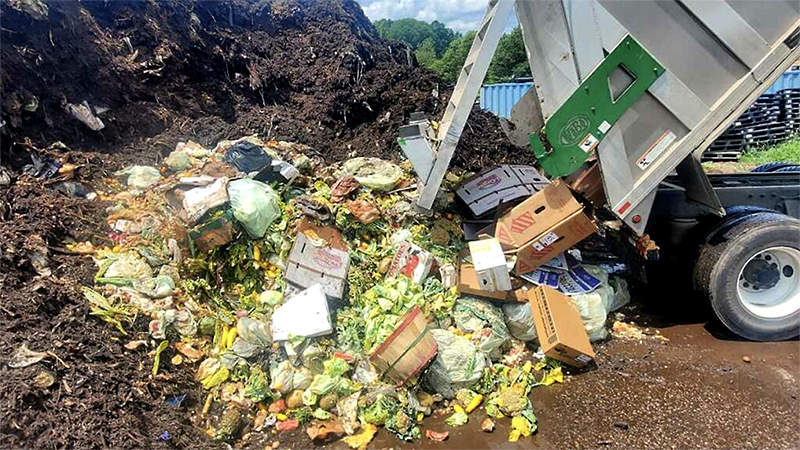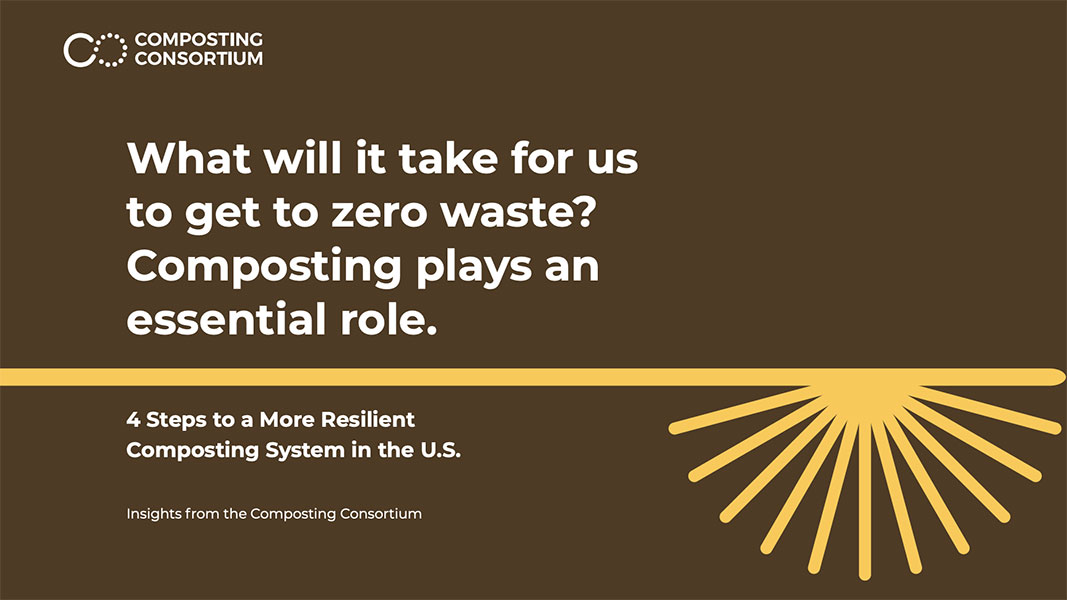The Composting Consortium is a multiyear industry collaboration managed by Closed Loop Partners’ Center for the Circular Economy, convening stakeholders across the entire value chain to pilot industry-wide solutions and build a roadmap for investment in technologies and infrastructure that enable recovery of compostable food packaging and food scraps. The Consortium recently released an insights brief that asks the question, “What will it take for us to get to zero waste? Composting plays an essential role.” The brief identifies four steps to “a more resilient composting system in the U.S.”
The introduction cites the fact that most commercial composting facilities in the U.S. today are set up to accept only yard trimmings. “While compostable packaging presents a potential opportunity to recover the food scraps that come with food packaging, its rapid growth trajectory is not matched with a similar growth in recovery capacity,” writes Kate Daly, Managing Director of the Center who authored the brief with the Composting Consortium team. “Only 2% of composting facilities in the U.S. today accept and process compostable packaging. Driven by a demand for alternatives to traditional fossil fuel-based, single-use plastic packaging, compostable packaging material has risen in volume in recent years, adding another variable to the organics stream.”
Its use is projected to grow as more state and local governments adopt restrictions on single-use plastics packaging. “The composting industry is now at a turning point,” continues the introduction. “Architecting an industrial composting system that can effectively process large volumes of food waste, and the compostable packaging that may come with it, will require restructuring economic incentives to accept these materials, aligning policy creation with infrastructure expansion, expanding access to composting and educating toward new patterns of consumption.”

Example of incoming feedstocks that include food and compostable packaging. Photo courtesy of The Compost Company (Nashville, TN)
The four initial steps needed to advance this restructuring and alignment include:
- Strengthen economic incentives for composting facilities to process food waste and food-contact compostable packaging. Composters must be adequately compensated as they transition away from processing just yard trimmings to processing yard trimmings as well as food waste and certified compostable packaging. Boosting food waste diversion includes support for the development of new and expanded end markets and accelerated adoption of policies and procurement practices that tap into the benefits of compost utilization — all of which ensures that the industry scales sustainably and operators are made whole for their contributions to circularity in organics.
- Address physical and chemical contamination of compost, both upstream and downstream. Mitigating contamination begins upstream, by eliminating pollutants, such as PFAS and persistent herbicides that negatively affect compost utilization or impose costly treatment requirements at the organics recycling facility. Look-alike packaging that appears compostable but is not must also be designed out by standardizing labeling for certified compostable packaging to reduce confusion and complexity. Certifying bodies are also an important part of this process, and it is up to manufacturers and brands to seek certification to add credibility to their products and claims. Packaging regulations that set certification, design, labeling and food-contact requirements can help reduce confusion. Further downstream, investment is needed in technologies that remove contamination and improve source separation of certified food-contact compostable packaging.
- Support the transition and expansion of composting infrastructure. In tandem with economically viable contracts with municipalities and commercial entities that divert organics, infrastructure capacity must be built, expanded and retrofitted to accommodate food waste diversion. In the short- and medium-term, upgrading existing composting facilities that can only accept yard trimmings is necessary to enable successful composting of source separated food scrap streams. If diverting certified compostable packaging does improve the total quantity of food scraps diverted, all of that packaging should meet one of these tests: either it provides economic value to the composting facility or it remains a neutral input in the composting process, so that packaging does not negatively impact the quality of the finished compost product or interfere with the breakdown times compost manufacturers need to meet today. In the long-term, new projects and facilities that accept all valuable feedstock, which may include certified compostable packaging as well as food scraps, are needed to expand capacity.
- Support local, state and federal legislation that incentivizes organics diversion. Aggressive and diverse capital and thoughtful legislation are required to ensure that organics recycling infrastructure is scaled to meet ambitious municipal goals and growing consumer demand. Organics disposal bans and mandates, local requirements to make curbside and/or drop-off organics recycling service available to all households, and pay-as-you-throw schemes are critical tools to improving the system, but when crafting these regulations, policymakers must consider the operational realities of composting facilities and drive the appropriate economic incentives to achieve the infrastructure upgrades necessary for the composting system to scale up.
“By working collaboratively and applying a systems-level approach to our work, we can move the needle more quickly on the challenges within the composting industry,” conclude the authors. “Buy-in from all stakeholders — compost manufacturers and facilities, waste haulers, brands, packaging manufacturers, investors, nongovernmental organizations and governmental agencies — is critical.”













